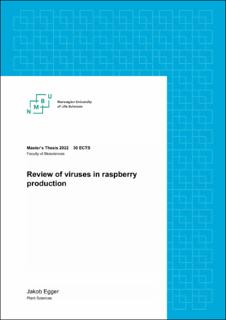| dc.description.abstract | Raspberries are one of the commercially most important kinds of berry fruits. Botanically, they are members of the large and diverse genus Rubus and belong to the greater rose family (Rosaceae). The raspberry shrub shares many characteristics with roses - beside the spines and bristles also a susceptibility for many fungal, bacterial and viral pathogens. This review talks about general knowledge of raspberries: their use, challenges, worldwide production and breeding efforts. However, the main part of this review focuses on diseases of the raspberry shrub, with a special emphasis on viral agents of disease. As is the case for plant viruses in general, raspberry viruses need vector animals to gain entry into the cell where they can use the nucleic acid machinery to replicate their own genetic material (Wilson, 2014). In raspberries, the role of vector is primarily performed by aphids (for overground infection) and nematodes (for underground infection). Nevertheless, many viruses capable of attacking the raspberry plant use lesser known vectors such as mites and whiteflies or infiltrate the pollen of a host plant to be expelled, transported and ultimately proliferated by the wind.
This review also contains a smaller body of work in the form of an experimental section. There, inoculation experiments of eight virus isolates on test plants are described. Inoculation experiment are performed using traditional sap inoculation from frozen leaf material. Nicotiana spp. and Chenopodium quinoa are used as test plants. In a separate inoculation experiment, fresh fine root material from ten samples was used to test for arabis mosaic virus (ArMV) vectored by the dagger nematode genus (Xiphenema spp.) Bioassays are concluded by re inoculation of suspected ArMV-diseased plants to confirm virus transmissibility.
In order to evaluate the species relationship of the virus isolates used in the bioassay, three ELISA-tests were performed to test harvested virus samples for tomato black ring virus (TBRV) and ArMV. In a separate molecular analysis, ribonucleic acid (RNA) was extracted from suspected ArMV, TBRV and beet ringspot virus (BRSV). The RNA was converted via reverse transcriptase to cDNA, amplified with polymerase chain reaction (PCR) and separated into size-specific molecular fragments using gel-electrophoresis.
Two of the studied virus isolates were identified as TBRV (Campanula isolate 2000 and Begonia isolate 1996), but the other six isolates studied could not be clearly identified. The isolate from roots of raspberry from a Xiphinema location gave test plant results indicating ArMV. | en_US |

